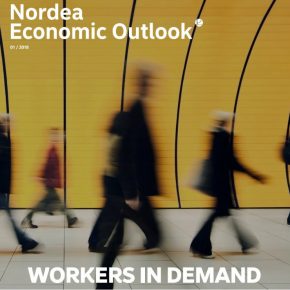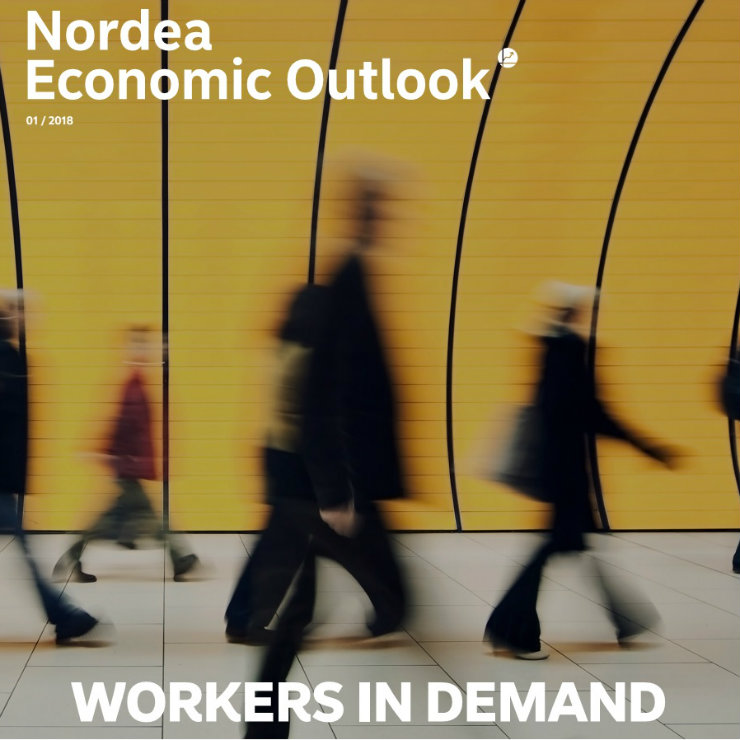
(Nordea, Public domain)
The improved economic conditions could deter workers from leaving this region or even lure them back home, increasing the demand for workers in the Western Europe and driving up wages. Helge J. Pedersen, Nordea Group Chief Economist, stated “The competition for labor is intensifying. Globalization has affected labor markets. The “Polish plumber” became a symbol of the cheap labor from CSE that many feared would flood the western European labor markets.”
This phenomenon quickly became a reality he argues. Cheap labor helped keep markets flexible and wages low, especially in the Western Europe, which was at a more developed stage than the east.
But a reversal is on the cards. “The upturn in the CSE countries is now so strong, that labor shortages have driven the rate of wage increases so high that there may be fewer who seek their fortunes abroad and many may return to their home countries.”
The report takes the most obvious example – Poland. It does not predict the tipping point, but suggests this is looming ever closer. It cites the statistic that at the end of 2016 2.5 million Poles had been living abroad for more than three months. There are 788,000 living in the UK and 687,000 in Germany.
The Nordic countries account for a smaller but not insignificant share. In Norway, there are 85,000 Poles, in Sweden 49,000, Denmark 34,000 Finland 3,000. In order to fill its own labor gaps, Poland has hosted officially 1.2 million Ukrainian workers (there are other estimates putting this figure at 2 million).
Nordea states that Polish economy is in very good shape. Growth forecasts estimate 3,5 per cent in 2018 and 2019. The unemployment rate not only in Poland but in Hungary and the Czech Republic is at historically low levels. Wages in these three countries has started to rise.
42 per cent of Polish companies reported at the end of 2017 that they had difficulties in maintaining production because of labor supply difficulties (in 2013, this figure was 5 per cent). The slower growth of wages was due to the Ukrainian influx after 2014. Still, the average wage grew 5 per cent y/y in Q3’17 and 6-7 per cent in Q4.
Wage growth was even faster in Hungary and Czech Republic. Unemployment rates have dropped to the similar extend as in Poland but from lower levels. Minimum wage hikes in Hungary have helped push the wage growth to double digits.
Influence on the Western Europe
Nordea states that the German and UK market are as tight as in the CSE. The Eurozone as a whole is 1.5 years behind. Up to now, wage pressure has not been an issue and unemployment rates have been below that point at which wage growth increases. There is one reason for this, namely the labor flow from east to west.
Since labor costs may rise in the Western Europe, this could trigger central bank responses to normalize monetary policy earlier and more strongly than presently discounted in the rates and exchange markets,” write authors of the Nordea report.
Nordic Impact
The report acknowledges that wage pressures have been dampened by foreign labor influx since 2004-2007. Norway has recorded a fall in its usually high net immigration figures which were high until 2014. Net immigration is only slightly positive and relatively still low. The calming effect of cheap labor may be at an end as domestic growth recovers and Norwegian employers find it harder to fill vacancies with foreign labor.
Denmark has experienced a growth of 100,000 foreign workers since 2011. The report states that this phenomenon has contributed to labor market flexibility. There was no sign of a slowdown as of November 2017, but wage rises could be set off given the European context.
Finland has had a similar experience too. Net migration grew until 2013, then dropped during the recession and recovered in 2016. The differences between the Estonian and Finnish wage markets are diminishing (Estonia is one of the prime sources of labor to Finland).
Sweden is a tempting destination but not for CSE workers. 4,000 Poles are registered monthly but fewer are given residence permits. CSE immigration as at a lower level than refugee immigration. In the construction sector, the one most affected by CSE immigration, wages have risen faster than in other sectors. Trade unions reaction has prevented undue inflationary pressures from developing. The Swedish real estate is showing some signs of a slowdown, which may reduce the demand for labor. Nonetheless, if German and CSE wage levels rise, it may be difficult for Swedish wage levels not to follow suit.
The Global Context
The Report is confident about the global economic outlook and expects global GDP to keep to 4 per cent in 2018. Confidence is high, with favorable financial conditions and reduced political uncertainty. Risks are basically balanced. The key thing to watch is the progress of tax reform in the United States; this may stimulate inflationary pressures, but Nordea feels that the risks are worth it, as productivity and investments could be further stimulated. US tax reform could account for 0.25 per cent of American GDP growth.
The report is also favorable to the Eurozone. It admits that Germany will still be the main engine of growth but France’s reforms are also beneficial, by boosting overall confidence. Brexit still remains on the horizon and any growth will be sensitive to the progress of the Brexit negotiations.
The full report can be found here


